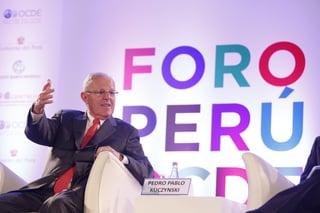
PPK's ambitious plans for water in Peru
Pedro Pablo Kuczynski Godard, better known as "PPK", became President of Peru in July this year.
 In his inaugural speech he set an objective that by 2021 all Peruvians should have access to drinking water 24/7 and be connected to sewerage services. PPK got involved with water before running for president. In 2007 he founded an NGO, Agua Limpia (“Clean Water”), which helps finance clean water systems and development projects in impoverished rural areas of Peru. Sceptics say that this was one of a number of efforts to modify his image as he built towards a run for the presidency.
In his inaugural speech he set an objective that by 2021 all Peruvians should have access to drinking water 24/7 and be connected to sewerage services. PPK got involved with water before running for president. In 2007 he founded an NGO, Agua Limpia (“Clean Water”), which helps finance clean water systems and development projects in impoverished rural areas of Peru. Sceptics say that this was one of a number of efforts to modify his image as he built towards a run for the presidency.
By any measure, the goal is hugely ambitious. The President’s first hurdle was to get the executive powers necessary to drive through change. Peru’s Congress has now granted special legislative powers to the government to enable it to legislate by decree over a 90-day period across five strategic areas – water/sanitation, economic regeneration, public safety, anti-corruption, and the restructuring of state-owned energy company Petroperu.
There are other hurdles. Time and money are not on his side.
PPK committed during his presidential campaign not to privatize water. The amount of capital that will be required for major infrastructure projects is huge. $6bn was spent on water and sewerage by the government during the 5 year term of the previous president. This increased access to drinking water from 77% of the population to 87%. Estimates suggest that the current government needs to invest a further $9bn to guarantee access to drinking water and sewerage services for 100% of the population.
The time it takes to deliver large infrastructure projects is typically 10 years. The 2021 deadline looms in just 5 years when PPK’s presidency comes to an end. “I have to be realistic,” he says, “public investment programmes take time. If we do it in seven years, it would still be a great achievement.”
Another hurdle is the scale of the challenge. Peru is a country of 30 million people. Around a third live in the capital Lima. As water shortages cause crop failure, people in rural Peru move to the cities placing additional demands on urban water networks, and adding to social problems.
i2O’s technology is already being trialled by water utilities in Peru including Emapica, Sedapar, Sedapal and Sedacusco. Smart water networks offer the country a cost-effective way to obtain benefits in the short-term with relatively little outlay. This would also buy time for the major infrastructure projects to be funded and delivered. The short-term benefits include immediate reduction in the amount of water wasted through leakage; an extension of the asset life of existing infrastructure; the ability to manage intermittent supply reliably and predictably; a reduction in energy costs; and an insight into the state of the network.
Tags: Blog, Public Policy & Regulation, LATAM